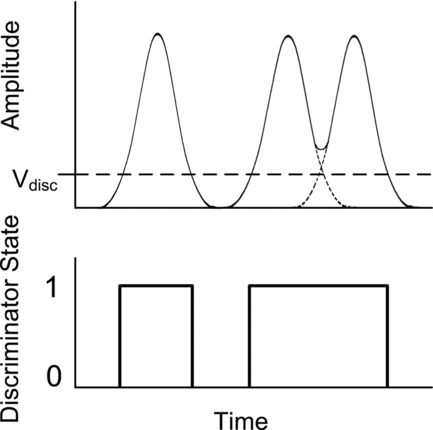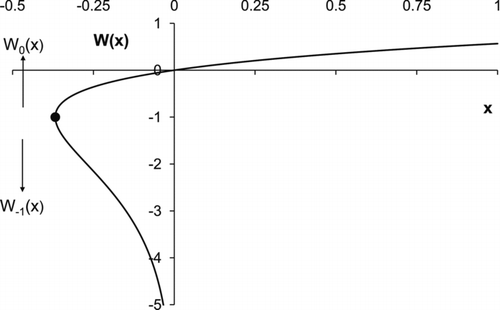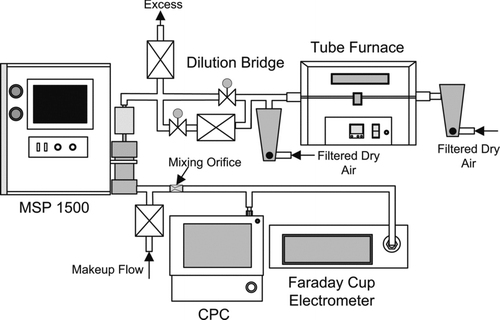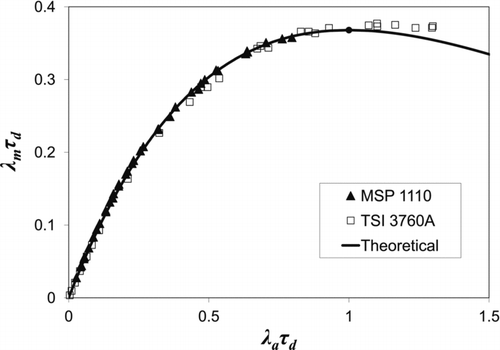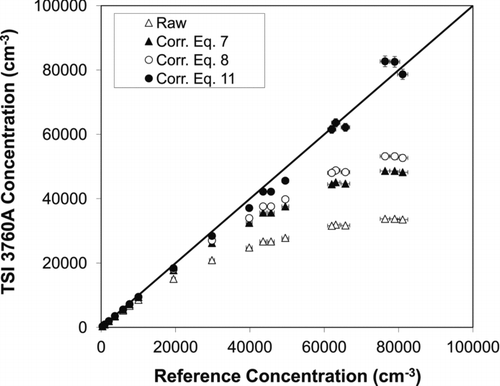Abstract
A new method for solving the theoretical rate of coincidence in a condensation particle counter (CPC) using the Lambert W function is described. The method, based on a Poisson process, corrects for the inherent effects of coincidence in particle counters, and provides an accurately determined true counting rate. Using an experimentally determined dead time for MSP Model 1110 and TSI Model 3760A CPCs, the method provided correction of up to 99% of the maximum count rate allowed by this method, with an average discrepancy of less than 4% when compared with a reference number concentration standard. The new coincidence correction method can be applied to any CPC with a known per-event dead time, extending its upper concentration measuring range by nearly one order of magnitude.
Copyright 2013 American Association for Aerosol Research
INTRODUCTION
Concerns have been raised about the health effects associated with long-term exposure to high concentrations of ultrafine particles, defined as having effective diameters of less than 100 nm. Although the total mass associated with ultrafine particles is typically small when compared with the mass of PM2.5, research indicates that the high ratio of surface area to mass makes these particles more efficient in the delivery of hazardous substances (Oberdörster Citation2000; Stoeger et al. Citation2006). Work by Bateson and Schwartz (Citation2004) has shown that exposure to high levels of ultrafine particles can be dangerous to the elderly, developing children, and those with pre-existing cardiopulmonary disease.
With typical roadway and urban aerosol ultrafine particle concentrations ranging between 40,000 and 500,000 particles/cm3 (Kittelson et al. Citation2004; Westerdahl et al. Citation2005), it can be challenging to make accurate concentration measurements with single-particle counters. One common type of single-particle counter, the condensation particle counter (CPC), typically has an upper concentration limit of 104 to 105 particles/cm3 in the single-counting mode. This upper concentration limit is imposed by the systematic reduction of the measured count rate due to the phenomenon known as coincidence. CPC manufacturers generally specify the maximum concentration of the instrument as the concentration at which the coincidence rate is 10% of the counting rate.
In this work, we define coincidence for a typical CPC and describe a coincidence correction method for the measured counting rate, and hence the concentration of the aerosol, which is accurate for a wide range of concentrations. This correction can be computed in real time with a relatively modest computer.
DEFINITION OF COINCIDENCE
The fundamental purpose of any counter is to measure as accurately as possible the number of discrete events occurring during a given period of time. In the case of the CPC instrument, in which particles grow into droplets via condensation of a working fluid, an event occurs when a droplet passes through the optical detection portion of the instrument. A discrete event is generated by the droplet traversing a spatially defined illumination source and scattering sufficient light energy to be detected by an electro-optical detector. An electrical signal, generally a pulse, is generated during such an event and counted with appropriate electronics.
One issue associated with this detection method is the phenomenon known as coincidence. Ideally, at any given time, only one particle at most will reside within the 3-dimensional (3D) region defined by the intersection of the light source, the stream of fluid containing droplets, and the 3D region optically mapped to the detector. The intersection of these three regions is commonly known as viewing volume, sensing volume, or measurement volume. However, there is always a finite probability that two or more particles will be present in the viewing volume at a given instant. The electrical signals produced by two or more droplets residing simultaneously in the viewing volume may be indistinguishable from one another, depending on the magnitudes and shapes of the signals, the time difference(s) between them, and the method of counting an individual pulse. This occurrence is known as a coincidence event. As the concentration of particles (droplets) in the media increases, the probability of a coincidence event naturally increases.
Depending on the profile of the light source that the droplet traverses, the microphysical structure of the droplet, and the response of the detection system, the electrical pulse can take on many possible forms. In this work, we will restrict the discussion to a simple case of a pulse consisting of a continuous waveform with amplitude that begins and ends at a steady-state baseline level and has a single peak. The most common light source profile is Gaussian, associated with the fundamental transverse electromagnetic mode of the ubiquitous laser. Such profiles are depicted in . It is important to specify the definition of width when discussing Gaussian pulses. A typical definition is the duration of time that the pulse amplitude is above a given fraction of the peak amplitude. Fractions commonly used for such a definition include 1/e 2, 1/2 (full-width at half-maximum; FWHM), and 1/10 (full-width at tenth-maximum; FWTM).
The optical detection portion of a CPC usually employs a simple signal-level discriminator to determine when an event has occurred. An event is considered to have occurred when the signal has exceeded and then dropped below the discriminator threshold (trigger) level (Vdisc in ), thus changing the discriminator state from 0 to 1 and then back to 0. In terms of electronic components, the discriminator is typically a comparator, and is the bridge between analog signal processing electronics and digital counting electronics.
If two particles are spatially close enough to each other within the viewing volume, they will produce signals that overlap, as depicted in . If the resulting waveform continually exceeds the trigger level from the rising edge of the first pulse to the falling edge of the second pulse, as shown on the right-hand side of , the counting electronics will not recognize this as two particles, but rather as only one. The second event follows the first event too soon to allow the signal amplitude to fall below the discriminator threshold level, thereby resetting it. The discriminator output is held high until the amplitude falls below the discriminator threshold level at the end of the second pulse.
When the discriminator is held high for this period of time, the counter is referred to as dead; it is unable to count additional pulses during this time period. Dead time is simply defined as the amount of time during a sample time interval that the system cannot accept any new count events. This may be due to optical coincidence, as described above, but slow electronics may further extend the dead time.
One commonly used method to determine the actual count rate Na is to correct the measured counts by deducting the dead time from the total sample time (TSI Citation2002; Hering et al. Citation2005):
COINCIDENCE CORRECTION
In this section, we present a method that provides a true correction for coincidence based on the measured counting rate of a CPC.
Since the rate of particles entering the CPC occurs at random, the counting system can be described by a Poisson process (Willeke and Liu Citation1976). To statistically determine the effect of coincidence on the actual count rate, we can describe the probability, P, of x number of events occurring at a given rate, λa , in a time interval of (T, T + Δt) as
In modeling the counting as a Poisson process, one can calculate the probability that an event has occurred, followed by a period of Δt in which no events occurs. This can be described simply as the probability that no events occur over a period of Δt due to the memory-less property of a Poisson process:
When modeling a system with coincidence, one is interested in the probability in which one or more events occur over the time period in which the system is dead. The time period of interest, Δt, represents the per-event dead time, τd . Thus, the probability that particles would be coincident at the actual count rate, λa , is
In terms of a counting model, this represents the fraction of particles that are coincident, yielding the following relation between the measured count rate, λm , and λa :
This equation has been commonly used to model the effect of coincidence in optical particle counters (Jaenicke Citation1972). EquationEquation (6), however, cannot be solved analytically in closed form. Several approximations to the solution have been posed. One common approximation (Zhang and Liu Citation1991; TSI Citation2002) substitutes λa for λm in the exponent, yielding
Hermann and Wiedensohler (Citation2001) and Takegawa and Sakurai (Citation2011) used a first-order Taylor series expansion to derive the following approximation to EquationEquation (6):
In order to provide a more accurate result, however, the order of the Taylor series expansion must be increased. This results in an expression that is more difficult to solve mathematically and computationally.
Another solution, proposed by Willink (Citation2009), makes use of the Lambert W function to solve EquationEquation (6). The Lambert W function is defined as follows:
The Lambert WFootnote 1 function consists of two branches when both x and y are real numbers. These branches are often denoted W0 and W−1 and are real-valued for values of x ≥ −1/e. As shown in , the Lambert W function is double-valued when −1/e ≤ x < 0.
Formatting EquationEquation (6) for use with EquationEquation (9) simply requires that both the left and right sides be multiplied by –τd , resulting in the following form:
shows the resulting function plotted as a function of the actual count and dead time. The solution is always bounded by the values 0 ≤ λmτd ≤ 1/e and for each value of λm there are two possible values for λa . For the case of particle counters, assuming that no additional information about the total dead time is available, the solution is constrained to the values dictated by the W0 branch of the Lambert function, i.e., the branch to the left of the peak in . This limits the maximum measured count to λmτd ≤ 1/e, and the maximum actual count rate to 1/τd . also shows solutions to EquationEquations (7) and Equation(8), clearly indicating significant deviations from the exact solution at high counts.
FIG. 3 Theoretical response of counter calculated using approximations (EquationEquations (7) and Equation(8)) and the Lambert W function (EquationEquation (10)).
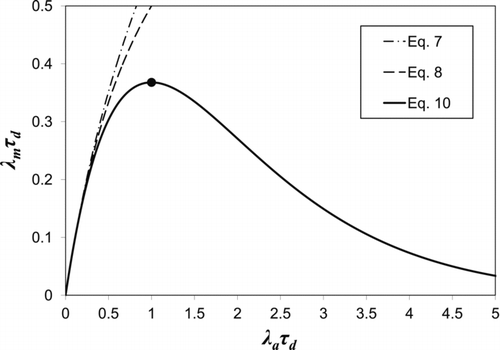
Since most particle counters provide measurements in the form of concentration, EquationEquation (10) can be written as
The method described herein makes the implicit assumption that for each event, coincident or not, the value for the dead time is the same for each event. In most counters, the magnitude of the pulse height and the resulting pulse width varies from particle to particle, and therefore the dead time varies. In practice, it is simpler to use an experimental method for determining the average dead time of the system, as described in the following section.
EXPERIMENTAL VERIFICATION
The coincidence correction method described in the previous section was applied to count measurements from two CPCs: an MSP Model 1110 and a TSI Model 3760A, with respective sample flow rates of 3.0 L/min and 1.5 L/min. shows a schematic diagram of the experimental set up used to make the measurements. An evaporation–condensation aerosol generator (Scheibel and Porstendörfer Citation1983) was used to generate a high-concentration polydisperse NaCl aerosol. The concentrated aerosol was diluted using an adjustable dilution bridge before entering a differential mobility analyzer (DMA). The DMA, a coaxial cylindrical type (Liu et al. Citation2010), was controlled with an MSP Model 1500 Aerosol Generation and Monitoring (AGM) System. Prior to the count measurements, the size distribution of the polydisperse NaCl aerosol was measured by scanning electrical mobility analysis and found to be log-normally distributed with a typical modal diameter of 40 nm and a geometric standard deviation of 1.55.
For measurements using the MSP 1110, the DMA was operated at a sheath-to-aerosol flow rate ratio of 10:1, and 100-nm electrical-mobility-diameter particles were selected to conduct the tests. For the measurement with the TSI 3760A CPC, the DMA was operated with a sheath-to-aerosol flow rate ratio of 5:1, and a 40-nm electrical-mobility-diameter particle was selected. The use of a smaller particle diameter was required to obtain a higher concentration of monodisperse aerosol.
A particle-free flow was introduced downstream of DMA as make-up air to meet the demand from air sampling instruments. A 0.86-mm diameter orifice provided the necessary mixing of the monodisperse aerosol flow with the make-up airflow. Connected downstream was an MSP-designed Faraday cup electrometer (FCE), comprising an absolute filter in a Faraday cup connected to a Keithly 6517B electrometer. The FCE was operated at a flow rate of 3.5 L/min. Conductive tubing was used to connect instruments to the mixing orifice, and the length of the tubing was adjusted in proportion to the flow rate of the instrument to produce matched diffusional losses.
In order to correct for the effect of multiply charged particles in the monodisperse aerosol, the presence of which increases the measured current, the theoretical DMA transfer function (Knutson and Whitby Citation1975) and charge equilibrium conditions (Wiedensohler Citation1988) were used to calculate the fraction of multiply charged particles for the incoming particle size distribution measured prior to the run. For the MSP 1110 test case, the electrometer current measurements were reduced by 2.6% to account for the effect of doubly and triply charged particles. For the TSI 3760A test case, the electrometer current measurements were reduced by 5.0% to correct for doubly and triply charged particles.
EquationEquation (10) was used to calculate τd from the uncorrected CPC concentration and from the actual concentration as measured by the FCE. Using a least-square method, an optimum value of 525 ns was obtained for τd for the MSP 1110, which agrees well with the average pulse width (FWTM) of approximately 500 ns measured with an oscilloscope. This method was repeated for the TSI 3760A, with a resulting optimum value of 422 ns for τd , and a measured average pulse width (FWTM) of 380 ns for concentrations less than 1 × 104 cm−3. The discrepancy between the measured optical dead time and the fitted τd is most likely due to the additional internal electronic dead time of the CPC. It should be noted that each experimental data point in represents the average raw count rate over a 1-min sample interval.
compares the experimental data with theory, defined by EquationEquation (9) using the fitted value of τd . The experimental data agree well with the theoretical measured count rate for the MSP 1110, with an average error of less than 2.6%, over a wide range of count rates, from 7.8 to 97.8% of the theoretical maximum on the W0 branch.
Similarly, the data for the TSI 3760A show good agreement, with an average error of −3.7% for values on the W0 branch (λaτd < 1), and an average error of +3.5% for values of the W−1 branch (λaτd > 1). The change from negative to positive errors is most likely due to decreasing pulse width observed at high concentrations (i.e., approximately 330 ns at concentrations exceeding 6 × 104 cm−3), resulting in slight reduction in the average τd . This reduction in pulse width is suspected to be caused by vapor depletion within the CPC, reducing the average final droplet diameter and thus the optical pulse width.
Converting the experimental data to number concentration provides a more practical representation of the new coincidence correction method. As shown in , the coincidence-corrected concentration for the MSP 1110 shows excellent linearity when compared with the reference concentration measured by the FCE up to a concentration of 3 × 104 cm−3. The maximum error of the corrected CPC concentration relative to the FCE reference concentration is 6.1% at a reference concentration of 6090 cm−3, well within the typical ±10% specified accuracy of commercial CPCs. also shows the coincidence-corrected concentrations using EquationEquations (7) and Equation(8), which underpredict the actual concentration by as much as 50% for the highest measured concentrations.
FIG. 6 Coincidence correction applied to MSP 1110 count data and comparison with approximations. The reference concentration was measured with a Faraday cup electrometer. The error bars represent 99% confidence intervals.
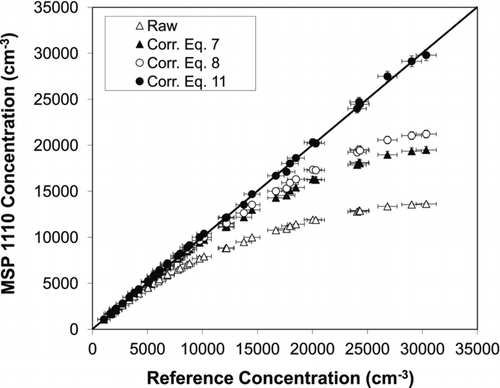
Without measurement of the dead time in a sample time interval, it is impossible to determine to which branch of the Lambert W function a concentration measurement corresponds. Therefore, only values that were known to lie on the W0 branch were corrected for the TSI 3760A data set. As shown in , the coincidence correction shows good agreement to the FCE reference concentration up to 8.2 × 104 cm−3. A maximum error of −7.9% occurs at 4.95 × 104 cm−3, with an average error of −3.7% for the data set. Using this method, the upper concentration limit of 1 × 104 cm−3 as specified by the manufacturer for 10% coincidence, has been increased by a factor of eight using a single value of the per-event dead time τd .
It should be noted that this method should only be applied to raw count (concentration) data, and must not be applied to count (concentration) values that have been corrected for coincidence by the instrument's operating software or firmware, i.e., internally corrected data. The use of internally corrected data may yield a system that cannot be modeled by a Poisson process, thereby invalidating the application of EquationEquation (6).
Furthermore, τd must be measured for each CPC, as small variations in τd due to variations in the optical dead time can result in large variations in the corrected count data as λmτd approaches unity. For count data near the upper limit of the W0 branch, a 10% error in τd would result in a 30% overestimate in concentration, whereas a −10% error in τd would result in only a −11% error in concentration. This is due to the exponential growth in coincidence as the count rate increases. At a moderate count rate and dead time, such as at λaτd = 0.2, this ±10% error in τd would result in roughly a ±2.5% error in concentration.
Without knowledge of the total dead time, there is an upper limit to the concentration that can be accurately determined using this new method (i.e., 1/τdQ). However, if the total dead time can be measured by the counter electronics, then the method can be extended to even higher concentrations (i.e., >1/τdQ) by making use of the W−1 branch of the Lambert W function.
SUMMARY
A new method for solving the theoretical rate of coincidence in a CPC has been described. This method calculates the true rate of coincidence using the Lambert W function, allowing the measured concentration to be corrected accurately. Using experimentally determined dead times for the MSP Model 1110 CPC and the TSI 3760A CPC resulted in corrections of concentrations of up to 3 × 104 cm−3 and 8 × 104 cm−3 with an average error of less than 4% when compared with a reference concentration measurement. The coincidence correction can be applied to concentration data from any CPC for which the volumetric flow rate through the detector is known and for which the average dead time can be measured.
Supplemental Information.zip
Download Zip (53.2 KB)Acknowledgments
[Supplementary materials are available for this article. Go to the publisher's online edition of Aerosol Science and Technology to view the free supplementary files.]
Notes
The Lambert W function can be found in popular commercially available computational software packages such as Matlab, Mathematica, and Octave. Included in the online supplemental information is an Excel macro for the Lambert W function.
REFERENCES
- Bateson , T. F. and Schwartz , J. 2004 . Who is Sensitive to the Effects of Particulate Air Pollution on Mortality? A Case-Crossover Analysis of Effect Modifiers . Epidemiology , 15 : 143 – 149 .
- Hering , S. V. , Stolzenburg , M. R. , Quant , F. R. , Oberreit , D. R. and Keady , P. B. 2005 . A Laminar Flow, Water-Based Condensation Particle Counter (WCPC) . Aerosol Sci. Technol. , 39 : 659 – 672 .
- Hermann , M. and Wiedensohler , A. 2001 . Counting Efficiency of Condensation Particle Counters at Low-Pressures with Illustrative Data from the Upper Troposphere . J. Aerosol Sci. , 32 : 975 – 991 .
- Jaenicke , R. 1972 . The Optical Particle Counter: Cross-Sensitivity and Coincidence . J. Aerosol Sci. , 3 : 95 – 111 .
- Kittelson , D. , Watts , W. , Johnson , J. , Remerowki , M. , Ische , E. Oberdörster , G. 2004 . On-Road Exposure to Highway Aerosols. 1. Aerosol and Gas Measurements . Inhal. Toxicol. , 16 ( s1 ) : 31 – 39 .
- Knutson , E. O. and Whitby , K. T. 1975 . Aerosol Classification by Electric Mobility: Apparatus, Theory, and Applications . J. Aerosol. Sci. , 6 : 443 – 451 .
- Liu , B. Y. H , Romay , F. J. , Dick , W. D. , Woo , K.-S. and Chiruta , M. 2010 . A Wide-Range Particle Spectrometer for Aerosol Measurement from 0.010 μm to 10 μm . Aerosol Air Qual. Res. , 10 : 125 – 139 .
- Oberdörster , G. 2000 . Pulmonary Effects of Inhaled Ultrafine Particles . Int. Arch. Occ. Env. Health , 74 ( 1 ) : 1 – 8 .
- Scheibel , H. G. and Porstendörfer , J. 1983 . Generation of Monodisperse Ag- and NaCl-aerosols with Particle Diameters Between 2 and 300 nm . J. Aerosol Sci. , 14 : 113 – 126 .
- Stoeger , T. , Reinhard , C. , Takenaka , S. , Schroeppel , A. , Karg , E. Ritter , B. 2006 . Instillation of Six Different Ultrafine Carbon Particles Indicates a Surface Area Threshold Dose for Acute Lung Inflammation in Mice . Environ. Health Perspect. , 114 ( 3 ) : 328 – 333 .
- Takegawa , N. and Sakurai , H. 2011 . Laboratory Evaluation of a TSI Condensation Particle Counter (Model 3771) Under Airborne Measurement Conditions . Aerosol Sci. Technol. , 45 : 272 – 283 .
- TSI . 2002 . Model 3025A Ultrafine Condensation Particle Counter Instrument Manual (Revision I) , St. Paul, MN : TSI Inc. .
- Westerdahl , D. , Fruin , S. , Sax , T. , Fine , P. M. and Sioutas , C. 2005 . Mobile Platform Measurements of Ultrafine Particles and Associated Pollutant Concentrations on Freeways and Residential Streets in Los Angeles . Atmos. Environ. , 39 ( 20 ) : 3597 – 3610 .
- Wiedensohler , A. 1988 . An Approximation of the Bipolar Charge Distribution for Particles in the Submicron Size Range . J. Aerosol Sci. , 19 : 387
- Willeke , K. and Liu , B. Y. H. 1976 . Fine Particles , Edited by: Liu , B. Y. H. New York : Academic Press .
- Willink , R. 2009 . On Dead-time Corrections for Estimating Rates . Meas. Sci. Technol. , 21 : 015101
- Zhang , Z. and Liu , B. Y. H. 1991 . Performance of TSI 3760 Condensation Nuclei Counter at Reduced Pressures and Flow Rates . Aerosol Sci. Technol. , 15 : 228 – 238 .
